remote control TOYOTA tC 2011 Owners Manual (in English)
[x] Cancel search | Manufacturer: TOYOTA, Model Year: 2011, Model line: tC, Model: TOYOTA tC 2011Pages: 473, PDF Size: 10.91 MB
Page 2 of 473
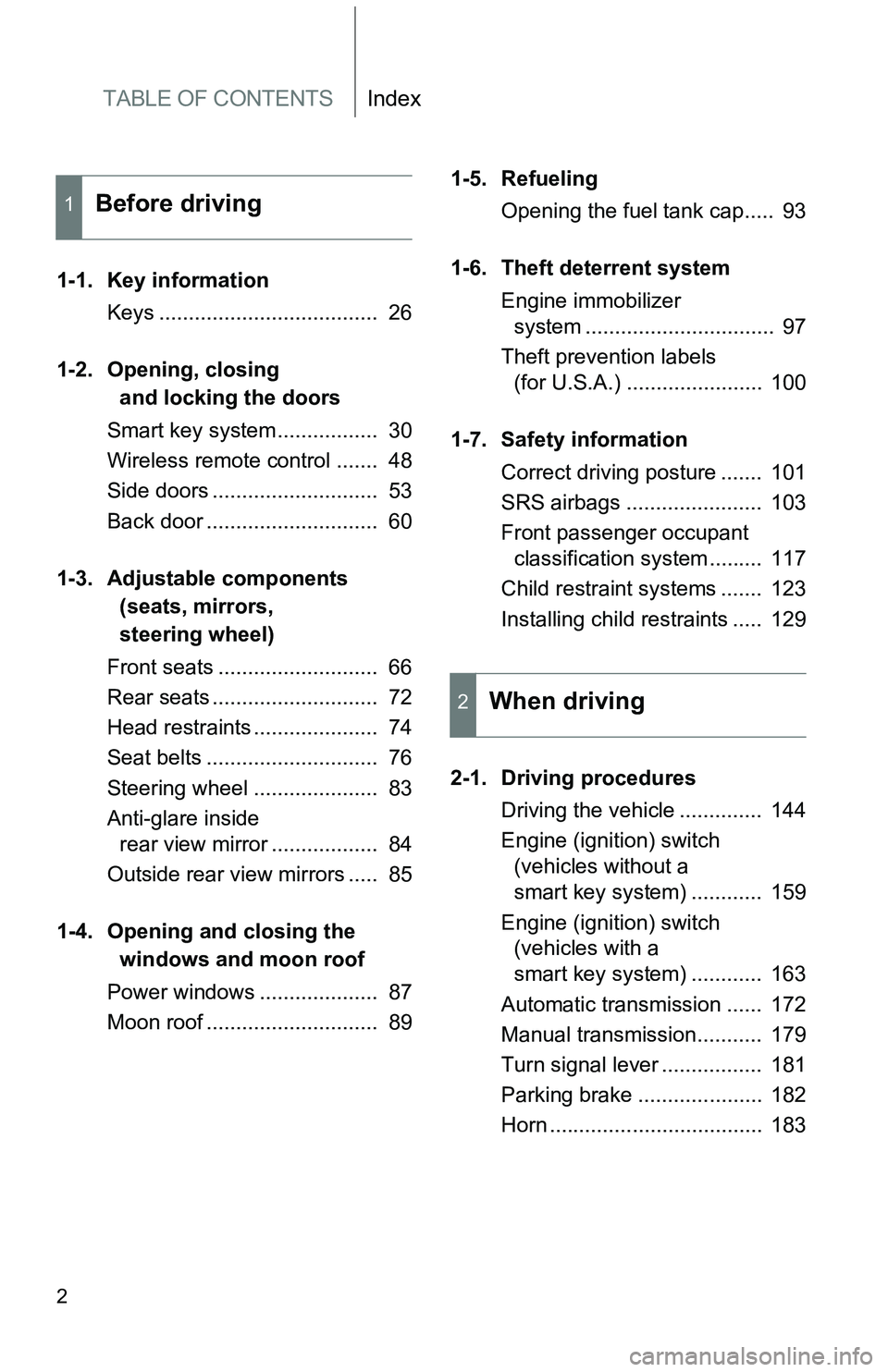
TABLE OF CONTENTSIndex
2
1-1. Key informationKeys ..................................... 26
1-2. Opening, closing and locking the doors
Smart key system................. 30
Wireless remote control ....... 48
Side doors ............................ 53
Back door ............................. 60
1-3. Adjustable components (seats, mirrors,
steering wheel)
Front seats ........................... 66
Rear seats ............................ 72
Head restraints ..................... 74
Seat belts ............................. 76
Steering wheel ..................... 83
Anti-glare inside rear view mirror .................. 84
Outside rear view mirrors ..... 85
1-4. Opening and closing the windows and moon roof
Power windows .................... 87
Moon roof ............................. 89 1-5. Refueling
Opening the fuel tank cap..... 93
1-6. Theft deterrent system Engine immobilizer system ................................ 97
Theft prevention labels (for U.S.A.) ....................... 100
1-7. Safety information Correct driving posture ....... 101
SRS airbags ....................... 103
Front passenger occupant classification system ......... 117
Child restraint systems ....... 123
Installing child restraints ..... 129
2-1. Driving procedures Driving the vehicle .............. 144
Engine (ignition) switch (vehicles without a
smart key system) ............ 159
Engine (ignition) switch (vehicles with a
smart key system) ............ 163
Automatic transmission ...... 172
Manual transmission........... 179
Turn signal lever ................. 181
Parking brake ..................... 182
Horn .................................... 183
1Before driving
2When driving
Page 4 of 473
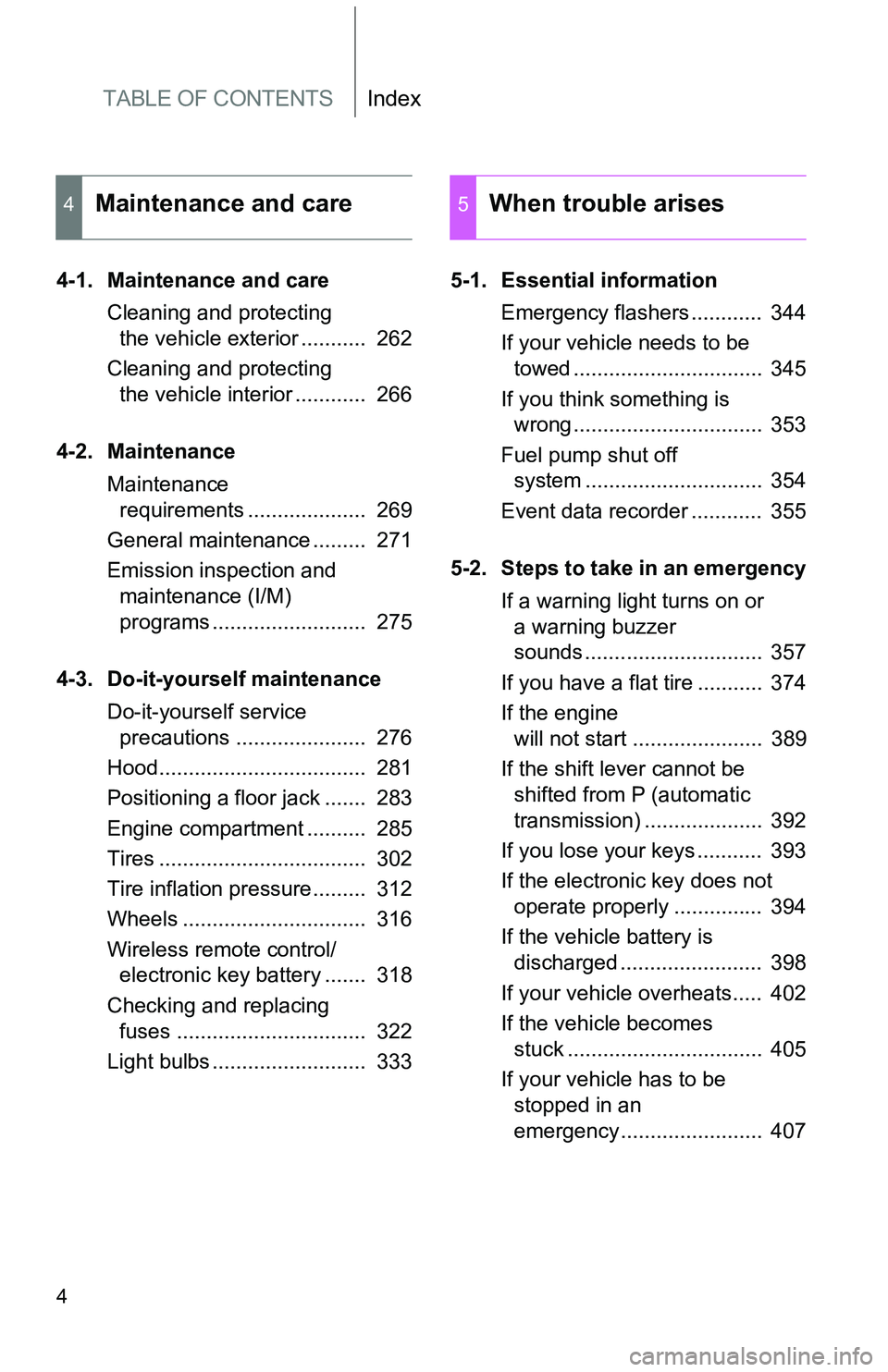
TABLE OF CONTENTSIndex
4
4-1. Maintenance and careCleaning and protecting the vehicle exterior ........... 262
Cleaning and protecting the vehicle interior ............ 266
4-2. Maintenance Maintenance requirements .................... 269
General maintenance ......... 271
Emission inspection and maintenance (I/M)
programs .......................... 275
4-3. Do-it-yourself maintenance Do-it-yourself service precautions ...................... 276
Hood................................... 281
Positioning a floor jack ....... 283
Engine compartment .......... 285
Tires ................................... 302
Tire inflation pressure......... 312
Wheels ............................... 316
Wireless remote control/ electronic key battery ....... 318
Checking and replacing fuses ................................ 322
Light bulbs .......................... 333 5-1. Essential information
Emergency flashers ............ 344
If your vehicle needs to be towed ................................ 345
If you think something is wrong ................................ 353
Fuel pump shut off system .............................. 354
Event data recorder ............ 355
5-2. Steps to take in an emergency If a warning light turns on or a warning buzzer
sounds .............................. 357
If you have a flat tire ........... 374
If the engine will not start ...................... 389
If the shift lever cannot be shifted from P (automatic
transmission) .................... 392
If you lose your keys ........... 393
If the electronic key does not operate properly ............... 394
If the vehicle battery is discharged ........................ 398
If your vehicle overheats..... 402
If the vehicle becomes stuck ................................. 405
If your vehicle has to be stopped in an
emergency........................ 407
4Maintenance and care5When trouble arises
Page 21 of 473
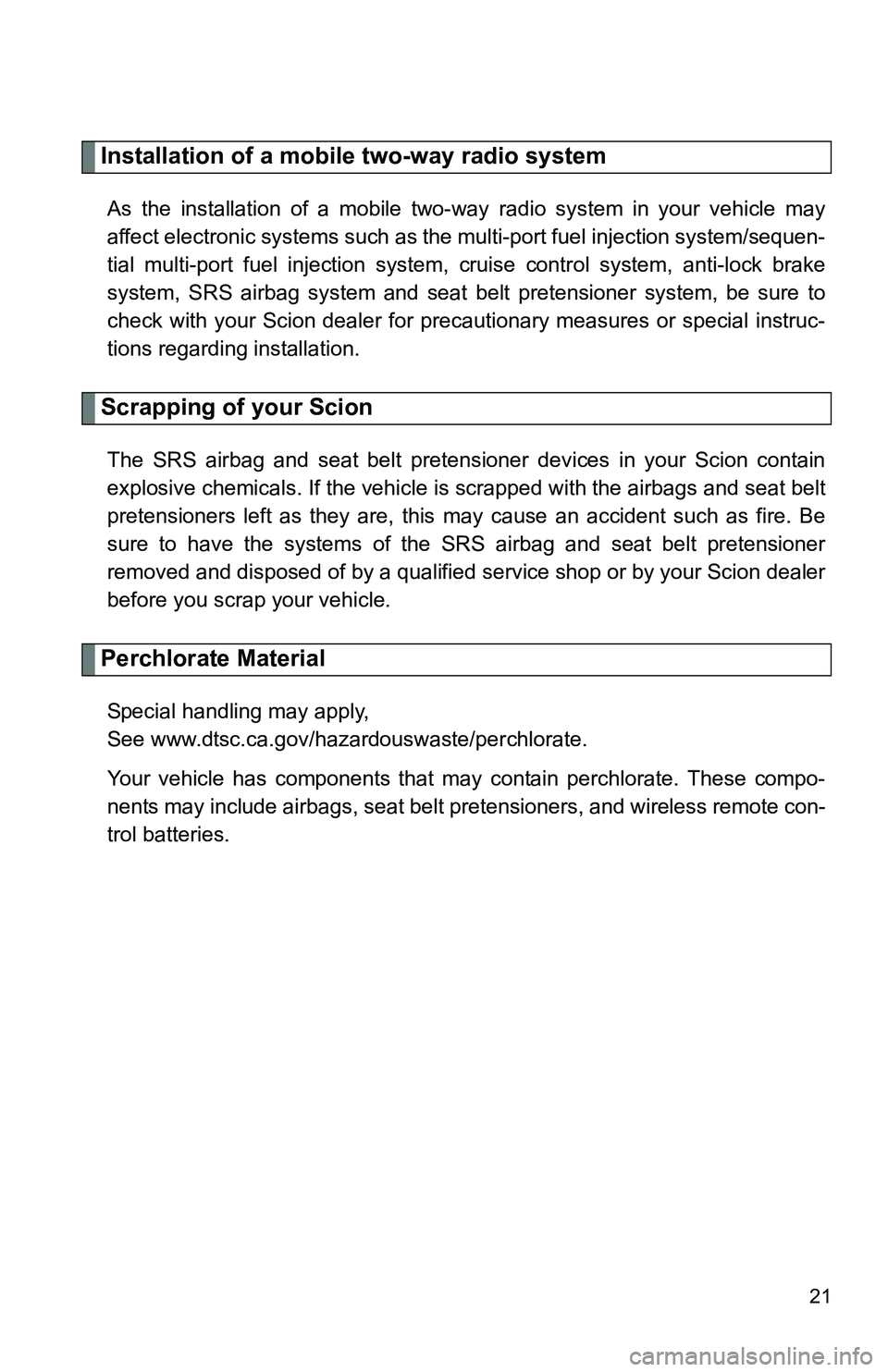
21
Installation of a mobile two-way radio system
As the installation of a mobile two-way radio system in your vehicle may
affect electronic systems such as the multi-port fuel injection system/sequen-
tial multi-port fuel injection system, cruise control system, anti-lock brake
system, SRS airbag system and seat belt pretensioner system, be sure to
check with your Scion dealer for precautionary measures or special instruc-
tions regarding installation.
Scrapping of your Scion
The SRS airbag and seat belt pretensioner devices in your Scion contain
explosive chemicals. If the vehicle is scrapped with the airbags and seat belt
pretensioners left as they are, this may cause an accident such as fire. Be
sure to have the systems of the SRS airbag and seat belt pretensioner
removed and disposed of by a qualified service shop or by your Scion dealer
before you scrap your vehicle.
Perchlorate Material
Special handling may apply,
See www.dtsc.ca.gov/hazardouswaste/perchlorate.
Your vehicle has components that may contain perchlorate. These compo-
nents may include airbags, seat belt pretensioners, and wireless remote con-
trol batteries.
Page 25 of 473
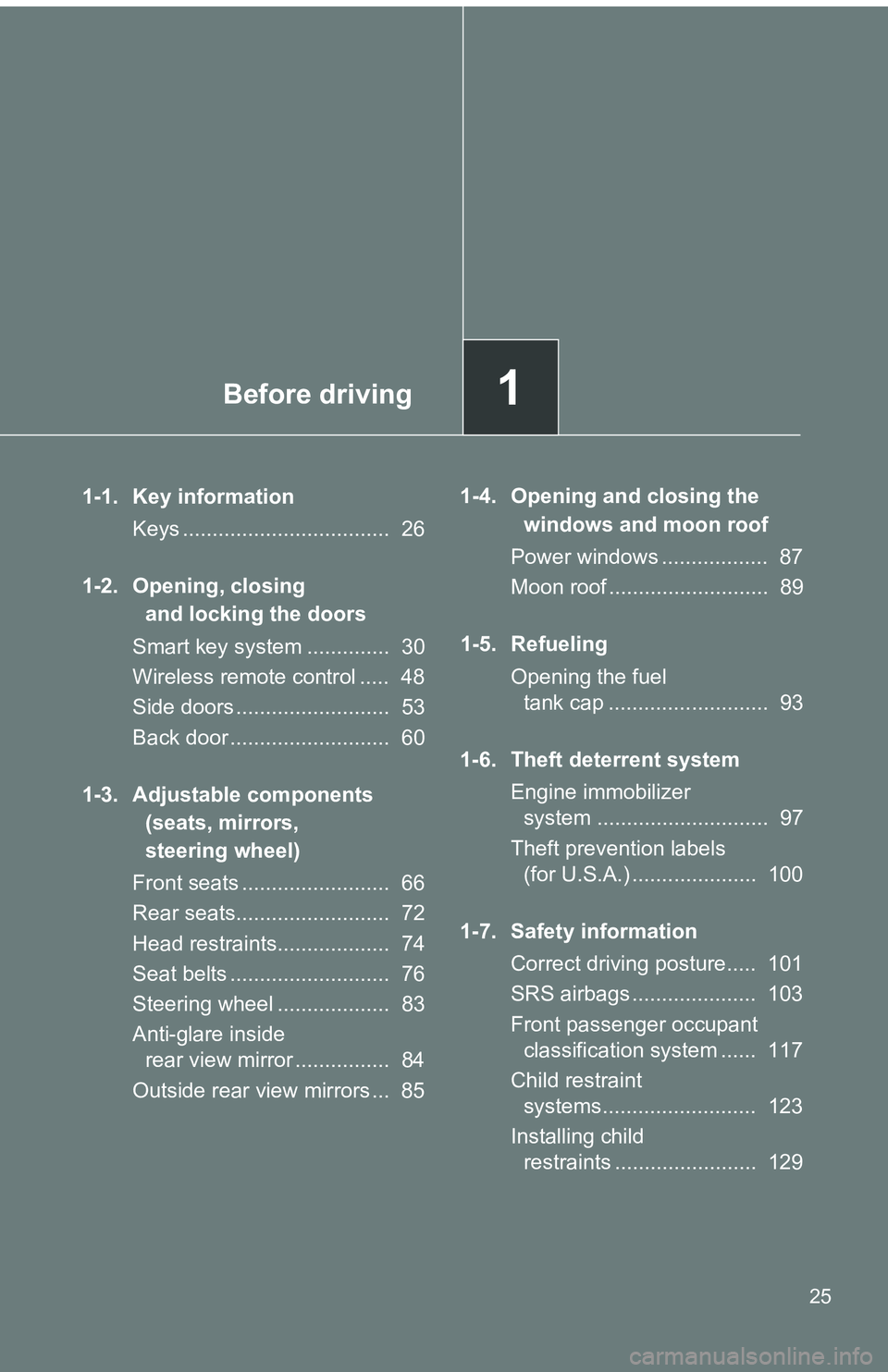
Before driving1
25
1-1. Key informationKeys ................................... 26
1-2. Opening, closing and locking the doors
Smart key system .............. 30
Wireless remote control ..... 48
Side doors .......................... 53
Back door ........................... 60
1-3. Adjustable components (seats, mirrors,
steering wheel)
Front seats ......................... 66
Rear seats.......................... 72
Head restraints................... 74
Seat belts ........................... 76
Steering wheel ................... 83
Anti-glare inside rear view mirror ................ 84
Outside rear view mirrors ... 85 1-4. Opening and closing the
windows and moon roof
Power windows .................. 87
Moon roof ........................... 89
1-5. Refueling Opening the fuel tank cap ........................... 93
1-6. Theft deterrent system Engine immobilizer system ............................. 97
Theft prevention labels (for U.S.A.) ..................... 100
1-7. Safety information Correct driving posture..... 101
SRS airbags ..................... 103
Front passenger occupant classification system ...... 117
Child restraint systems.......................... 123
Installing child restraints ........................ 129
Page 26 of 473
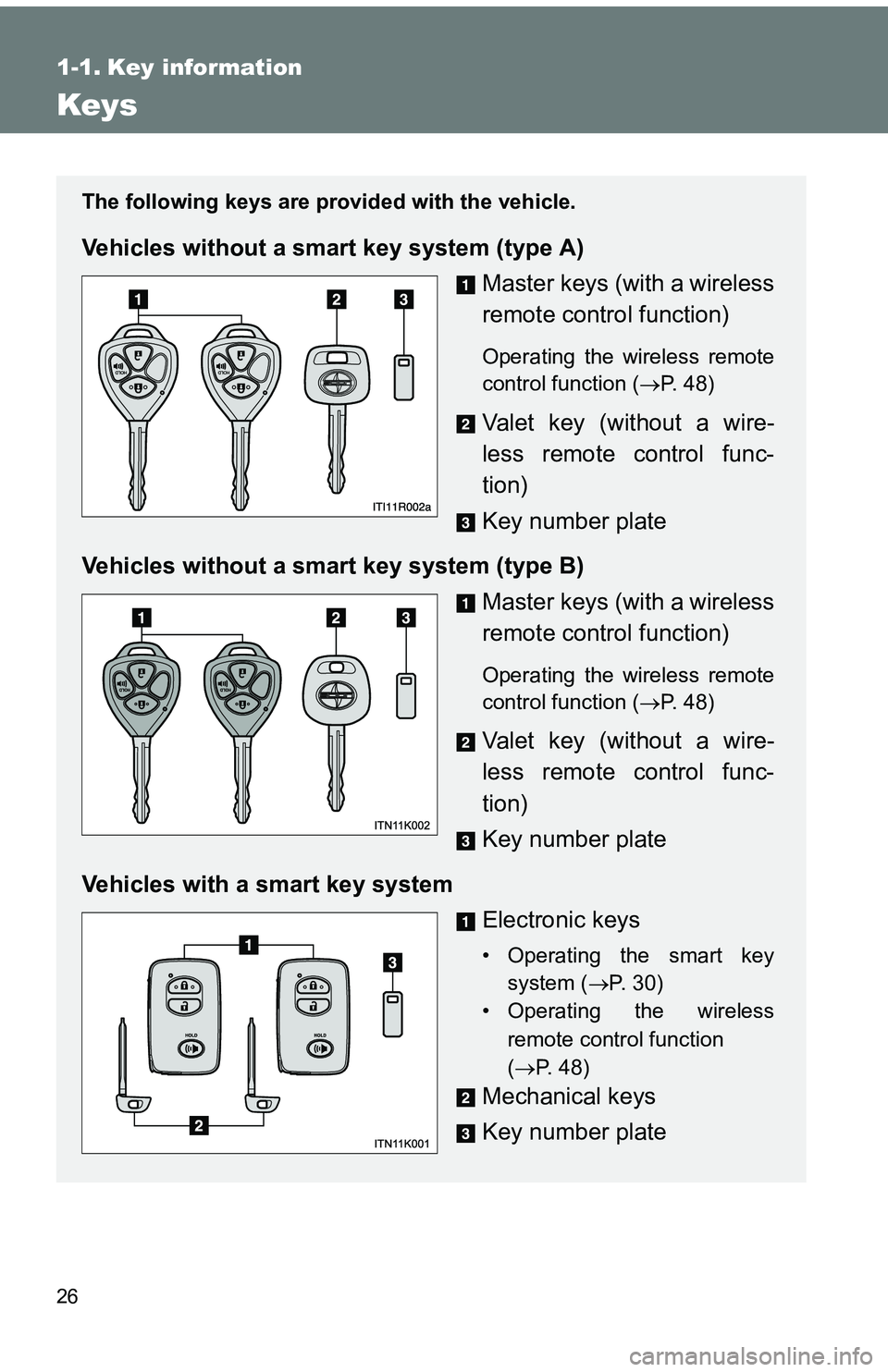
26
1-1. Key information
Keys
The following keys are provided with the vehicle.
Vehicles without a smart key system (type A)
Master keys (with a wireless
remote control function)
Operating the wireless remote
control function (P. 48)
Valet key (without a wire-
less remote control func-
tion)
Key number plate
Vehicles without a smart key system (type B) Master keys (with a wireless
remote control function)
Operating the wireless remote
control function (P. 48)
Valet key (without a wire-
less remote control func-
tion)
Key number plate
Vehicles with a smart key system Electronic keys
• Operating the smart keysystem ( P. 30)
• Operating the wireless
remote control function
(P. 48)
Mechanical keys
Key number plate
Page 28 of 473
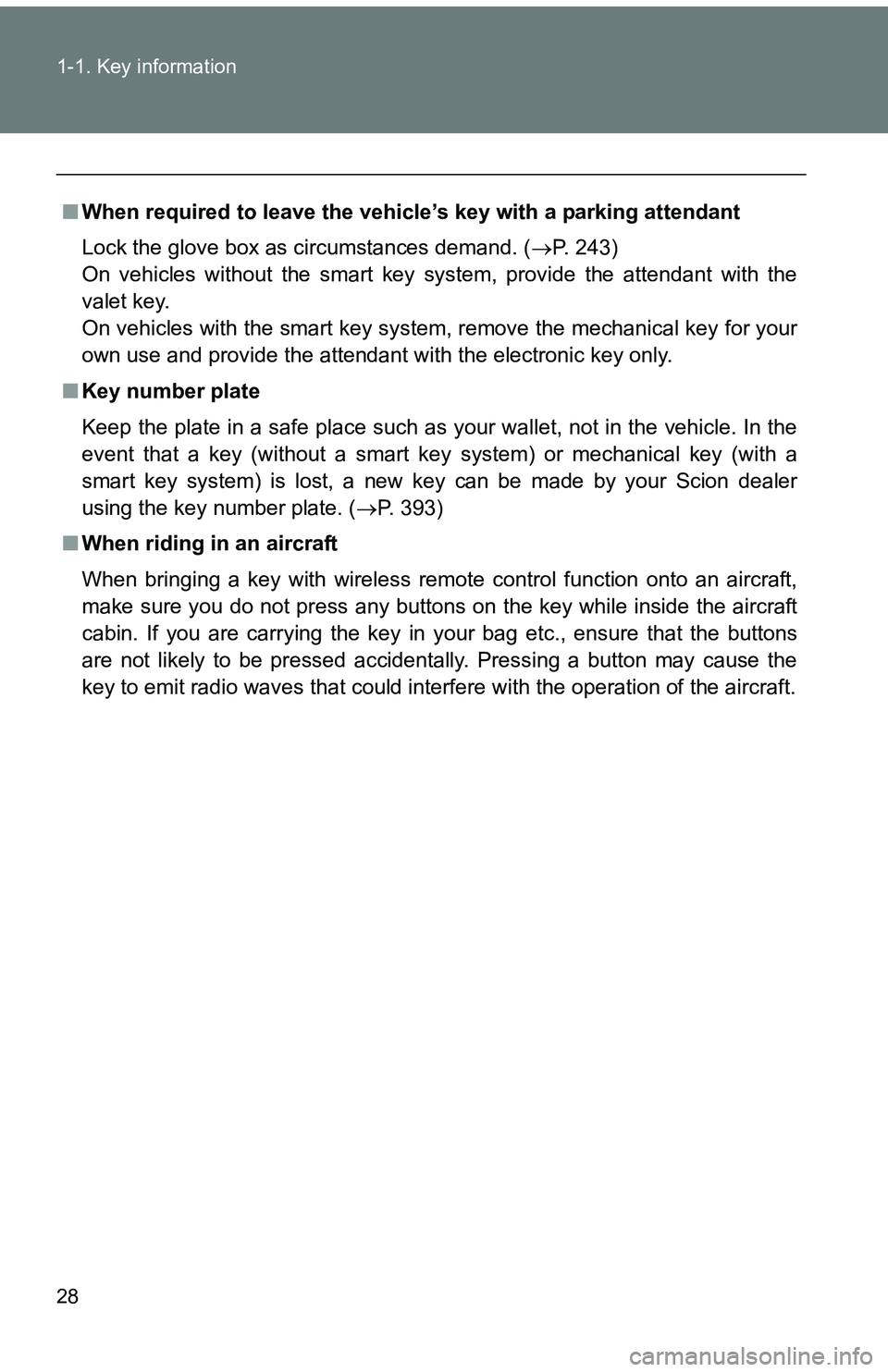
28 1-1. Key information
■When required to leave the vehic le’s key with a parking attendant
Lock the glove box as circumstances demand. ( P. 243)
On vehicles without the smart key system, provide the attendant with the
valet key.
On vehicles with the smart key system, remove the mechanical key for your
own use and provide the attendant with the electronic key only.
■ Key number plate
Keep the plate in a safe place such as your wallet, not in the vehicle. In the
event that a key (without a smart key system) or mechanical key (with a
smart key system) is lost, a new key can be made by your Scion dealer
using the key number plate. ( P. 393)
■ When riding in an aircraft
When bringing a key with wireless remote control function onto an aircra\
ft,
make sure you do not press any buttons on the key while inside the aircraft
cabin. If you are carrying the key in your bag etc., ensure that the buttons
are not likely to be pressed accidentally. Pressing a button may cause the
key to emit radio waves that could interfere with the operation of the a\
ircraft.
Page 39 of 473
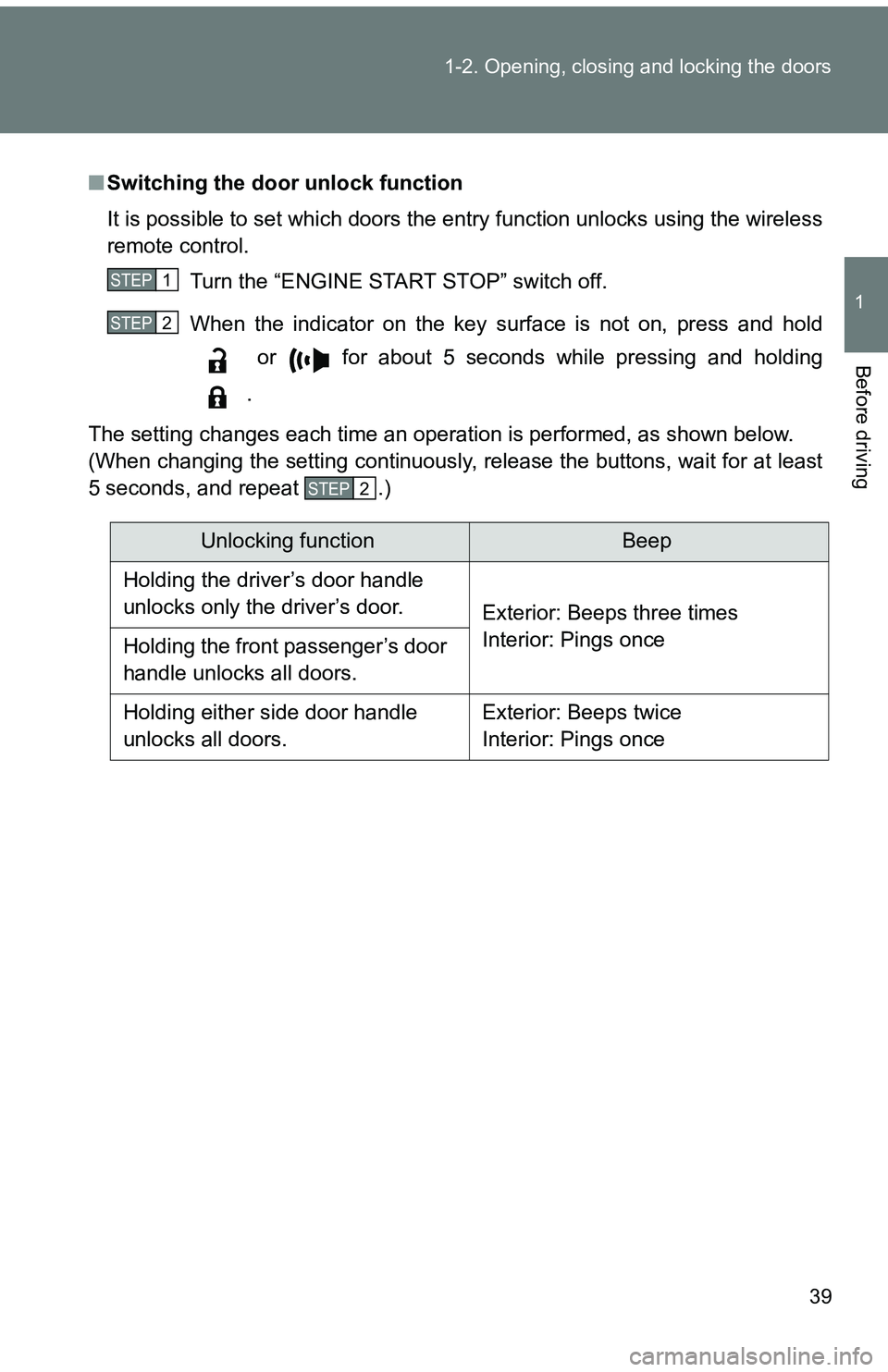
39
1-2. Opening, closing and locking the doors
1
Before driving
■
Switching the door unlock function
It is possible to set which doors the entry function unlocks using the wireless
remote control.
Turn the “ENGINE START STOP” switch off.
When the indicator on the key surface is not on, press and hold or for about 5 seconds while pressing and holding
.
The setting changes each time an operation is performed, as shown below.
(When changing the setting continuously, release the buttons, wait for at least
5 seconds, and repeat .)
STEP 1
STEP 2
STEP 2
Unlocking functionBeep
Holding the driver’s door handle
unlocks only the driver’s door. Exterior: Beeps three times
Interior: Pings once
Holding the front passenger’s door
handle unlocks all doors.
Holding either side door handle
unlocks all doors. Exterior: Beeps twice
Interior: Pings once
Page 40 of 473
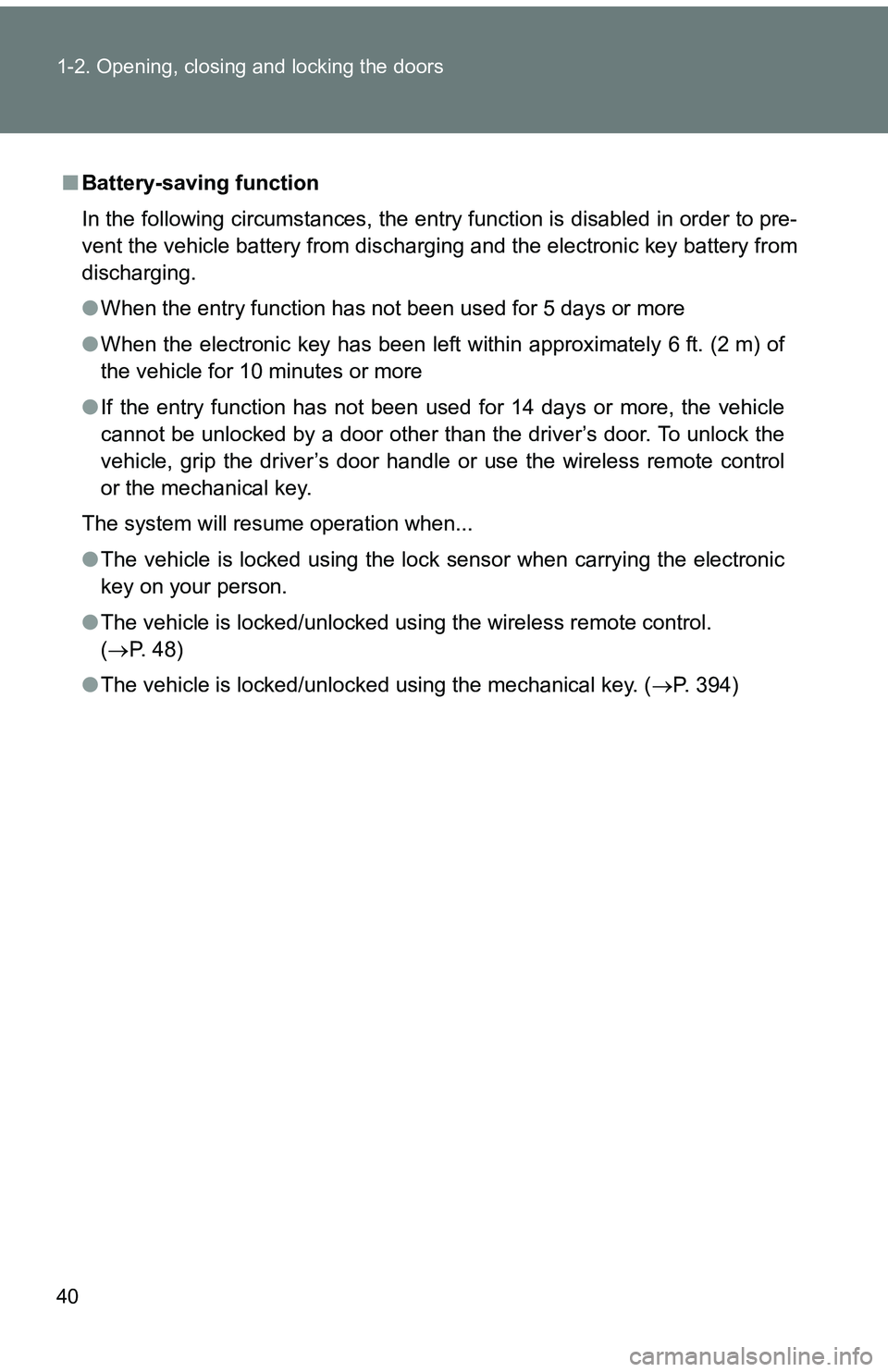
40 1-2. Opening, closing and locking the doors
■Battery-saving function
In the following circumstances, the entry function is disabled in order to pre-
vent the vehicle battery from discharging and the electronic key battery from
discharging.
●When the entry function has not been used for 5 days or more
● When the electronic key has been left within approximately 6 ft. (2 m) of
the vehicle for 10 minutes or more
● If the entry function has not been used for 14 days or more, the vehicle
cannot be unlocked by a door other than the driver’s door. To unlock the
vehicle, grip the driver’s door handle or use the wireless remote control
or the mechanical key.
The system will resume operation when...
● The vehicle is locked using the lock sensor when carrying the electronic
key on your person.
● The vehicle is locked/unlocked using the wireless remote control.
( P. 4 8 )
● The vehicle is locked/unlocked using the mechanical key. ( P. 394)
Page 41 of 473
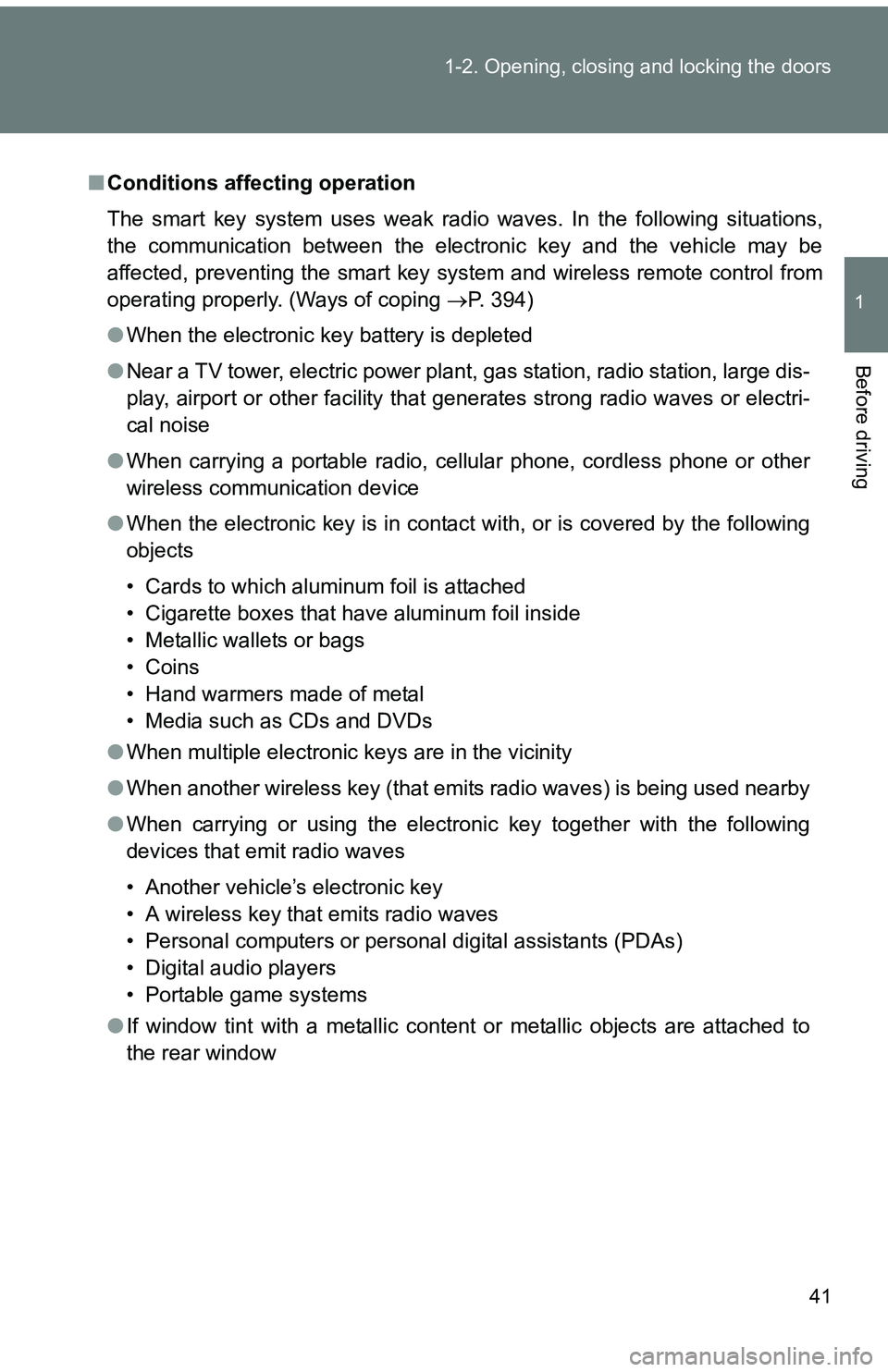
41
1-2. Opening, closing and locking the doors
1
Before driving
■
Conditions affecting operation
The smart key system uses weak radio waves. In the following situations,
the communication between the electronic key and the vehicle may be
affected, preventing the smart key system and wireless remote control from
operating properly. (Ways of coping P. 394)
● When the electronic key battery is depleted
● Near a TV tower, electric power plant, gas station, radio station, large dis-
play, airport or other facility that generates strong radio waves or electri-
cal noise
● When carrying a portable radio, ce llular phone, cordless phone or other
wireless communication device
● When the electronic key is in contact with, or is covered by the following
objects
• Cards to which aluminum foil is attached
• Cigarette boxes that have aluminum foil inside
• Metallic wallets or bags
• Coins
• Hand warmers made of metal
• Media such as CDs and DVDs
● When multiple electronic keys are in the vicinity
● When another wireless key (that emits radio waves) is being used nearby
● When carrying or using the electronic key together with the following
devices that emit radio waves
• Another vehicle’s electronic key
• A wireless key that emits radio waves
• Personal computers or personal digital assistants (PDAs)
• Digital audio players
• Portable game systems
● If window tint with a metallic content or metallic objects are attached to
the rear window
Page 42 of 473
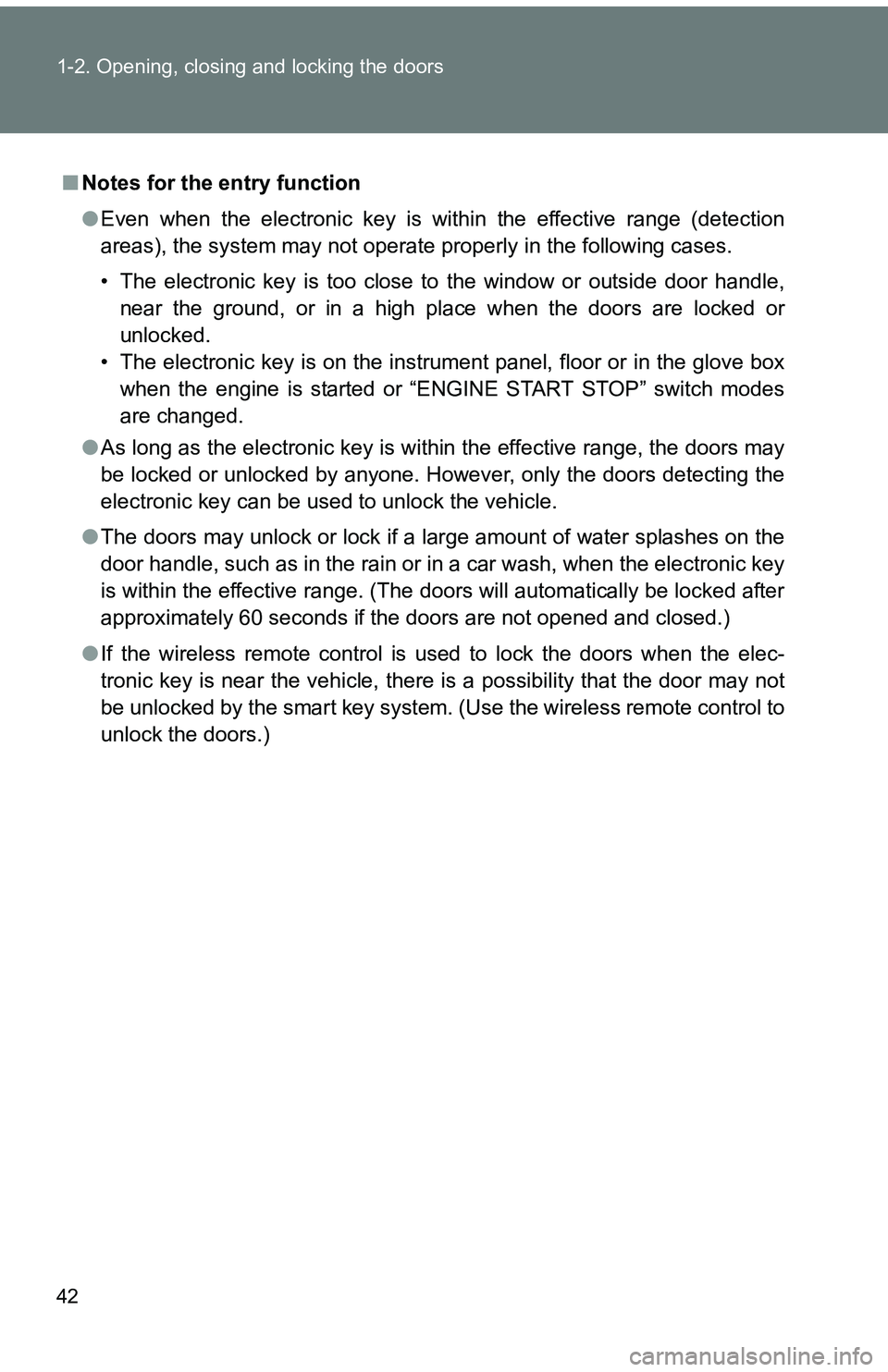
42 1-2. Opening, closing and locking the doors
■Notes for the entry function
●Even when the electronic key is within the effective range (detection
areas), the system may not operate properly in the following cases.
• The electronic key is too close to the window or outside door handle,
near the ground, or in a high place when the doors are locked or
unlocked.
• The electronic key is on the instrument panel, floor or in the glove box when the engine is started or “ENGINE START STOP” switch modes
are changed.
● As long as the electronic key is within the effective range, the doors may
be locked or unlocked by anyone. However, only the doors detecting the
electronic key can be used to unlock the vehicle.
● The doors may unlock or lock if a large amount of water splashes on the
door handle, such as in the rain or in a car wash, when the electronic key
is within the effective range. (The doors will automatically be locked after
approximately 60 seconds if the doors are not opened and closed.)
● If the wireless remote control is used to lock the doors when the elec-
tronic key is near the vehicle, there is a possibility that the door may not
be unlocked by the smart key system. (Use the wireless remote control to
unlock the doors.)